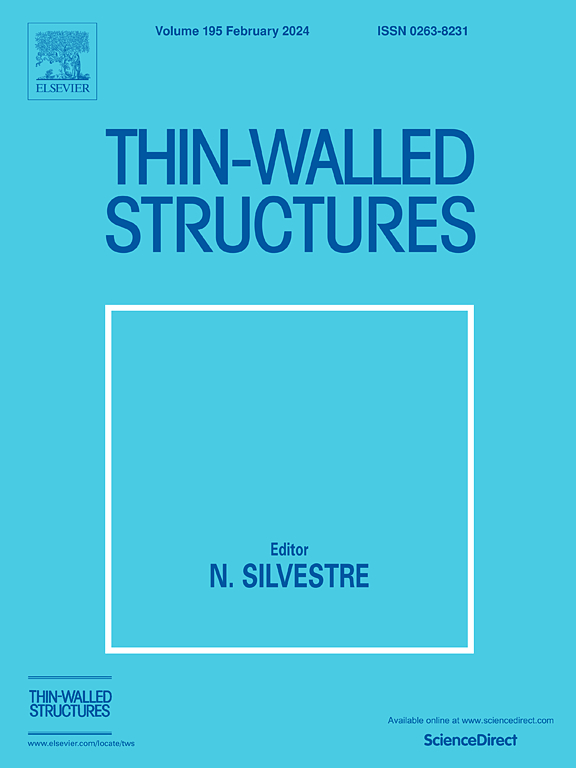Full active counter-roller spinning for thin-walled cylinders: Macroscopic deformation mechanism, mesoscopic texture evolution, and forming performance strengthening
IF 5.7
1区 工程技术
Q1 ENGINEERING, CIVIL
引用次数: 0
Abstract
The reliability and lightweight of hydrogen high-pressure storage present pressing global challenges. The forming mechanism of a novel full active counter-roller spinning (FACRS) process for thin-walled cylinders is studied from the perspective of macro‑meso coupling. This innovative process holds promise as a replacement for conventional mandrel spinning, enabling enhanced integration of form and property in manufacturing hydrogen bottle liners. Employing optimal Latin hypercube sampling, a response surface model is constructed for forming consistency (λ) of inner and outer surfaces, yielding an optimal set of process parameters under the Hooke-Jeeves algorithm. The resulting spun parts exhibit a more balanced and superior performance. A macro‑meso gradual cross-scale coupling simulation methodology is proposed, revealing that the process is characterized by the initial aggregation and subsequent reinforcement of texture, culminating in the formation of a "soft" rotated cubic texture, which still faces impediments or diminishes the orientation of texture. It is demonstrated that the evolution of texture is the result of the interactive coordination of various slip systems. Furthermore, the FACRS experiments and performance tests indicate that while enhancing the axial and circumferential mechanical properties of the spun parts, it also reduces material anisotropy. The grain refinement effect of the process has also led to a more uniform distribution of dimples on the fracture surface. The surface performance of the final spun parts improves by 60.11 %. These enhancements can be attributed to the combined effects of improved forming consistency, coordinated action of slip systems, and grain refinement. These results deepen the understanding of the macro‑meso deformation mechanisms underlying the novel process, providing valuable insights for further advancements in counter-roller spinning technology.
薄壁圆筒的全主动对辊纺纱:宏观变形机理、中观纹理演变和成形性能强化
氢气高压存储的可靠性和轻量化是一项紧迫的全球性挑战。本文从宏观-微观耦合的角度研究了用于薄壁圆筒的新型全主动对辊纺纱(FACRS)工艺的成型机制。这种创新工艺有望取代传统的心轴旋压工艺,从而在制造氢气瓶内衬时加强形状和性能的整合。利用最优拉丁超立方采样,构建了内外表面成形一致性 (λ) 的响应面模型,并根据胡克-杰维斯算法生成了一组最优工艺参数。由此产生的纺丝部件表现出更均衡、更优越的性能。研究提出了一种宏观-微观渐进跨尺度耦合模拟方法,揭示了这一过程的特点是纹理的初始聚集和随后的强化,最终形成 "软 "旋转立方纹理,但仍面临阻碍或纹理取向的减弱。实验证明,纹理的演变是各种滑移系统交互协调的结果。此外,FACRS 实验和性能测试表明,在提高纺丝部件轴向和周向机械性能的同时,也降低了材料的各向异性。该工艺的晶粒细化效果还使断裂面上的凹痕分布更加均匀。最终纺制部件的表面性能提高了 60.11%。这些改进可归因于成形一致性的改善、滑移系统的协调作用以及晶粒细化的综合效应。这些结果加深了人们对新工艺背后的宏观介质变形机制的理解,为进一步推动对辊纺纱技术的发展提供了宝贵的见解。
本文章由计算机程序翻译,如有差异,请以英文原文为准。
求助全文
约1分钟内获得全文
求助全文
来源期刊

Thin-Walled Structures
工程技术-工程:土木
CiteScore
9.60
自引率
20.30%
发文量
801
审稿时长
66 days
期刊介绍:
Thin-walled structures comprises an important and growing proportion of engineering construction with areas of application becoming increasingly diverse, ranging from aircraft, bridges, ships and oil rigs to storage vessels, industrial buildings and warehouses.
Many factors, including cost and weight economy, new materials and processes and the growth of powerful methods of analysis have contributed to this growth, and led to the need for a journal which concentrates specifically on structures in which problems arise due to the thinness of the walls. This field includes cold– formed sections, plate and shell structures, reinforced plastics structures and aluminium structures, and is of importance in many branches of engineering.
The primary criterion for consideration of papers in Thin–Walled Structures is that they must be concerned with thin–walled structures or the basic problems inherent in thin–walled structures. Provided this criterion is satisfied no restriction is placed on the type of construction, material or field of application. Papers on theory, experiment, design, etc., are published and it is expected that many papers will contain aspects of all three.
 求助内容:
求助内容: 应助结果提醒方式:
应助结果提醒方式:


